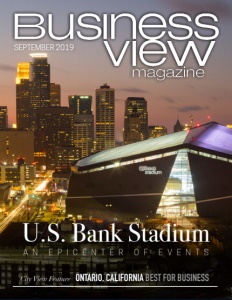Lancaster, California
A choice location
Business View Magazine interviews representatives of Lancaster, California, as part of our focus on energy alternatives in American communities.
Lancaster is a charter city in northern Los Angeles County, in the Antelope Valley of the western Mojave Desert in Southern California, just 70 miles north of downtown Los Angeles. It is separated from the Los Angeles Basin by the San Gabriel Mountains to the south and from Bakersfield and the San Joaquin Valley by the Tehachapi Mountains to the north. The area where Lancaster is now located was originally home to the Paiute Indians. Lancaster’s origins as a settlement start with the Southern Pacific Railroad, which is believed to first use the name Lancaster, where a station house, locomotive watering facilities, and section gang housing were built when the railroad laid track through the town’s future location. In 1876, the Southern Pacific completed the line through the Antelope Valley, linking San Francisco and Los Angeles.
The person credited with formally developing the town is Moses Langley Wicks, who, in 1884, bought property from the railroad for $2.50 per acre, mapped out a town with streets and lots, and advertised 160-acre tracts of land for $6 an acre. By 1890, Lancaster was bustling and booming, and thanks to adequate rainfall, farmers planted and sold thousands of acres of wheat and barley.
The town was devastated by the decade-long drought that began in 1894, killing businesses and driving cattle north, though fortunes improved somewhat in 1898, following the nearby discoveries of gold and borax, the latter to become a widespread industrial chemical and household cleaner. Thanks to the five-year construction of the 233-mile Los Angeles Aqueduct starting in 1908, Lancaster became a boom town by housing aqueduct workers.
The community began a steady growth spurt in the 1930s, starting with construction of Muroc Air Force Base, site of frequent flight tests, including the “breaking” of the sound barrier by Chuck Yeager in a Bell X-1A in 1947. The development of Air Force Plant 42 in 1958, augmented in the 1960s by construction of Lockheed Aircraft’s Plant 10, created tens of thousands of jobs with high-wage employment hitting its peak in the 1970s.

Mayor Parris at Jack Nothrop Elementary
Lancaster was an unincorporated community in Los Angeles County until 1977, when it was incorporated as a city. Aerospace is still one of the area’s biggest industries, and Lancaster is now home to major defense contractors such as Boeing, Northrop Grumman, Lockheed Martin, Virgin Galactic, BAE, and government agencies, such as the NASA Armstrong Flight Research Center, which are all active in design, testing, and manufacturing of a variety of military and commercial equipment. In addition to aerospace, highlights of Lancaster’s diversified economy include advanced transportation, health care, and manufacturing.
Lancaster’s current population is approximately 170,000 and the city houses approximately 75 percent of workers from nearby Edwards Air Force Base. And, according to the city’s Assistant to the City Manager, Chenin Dow, the number of aerospace workers in the community is expected to grow significantly. “Northrop Grumman is building the new bomber for the Department of Defense here in the Antelope Valley, and they’re in the process of hiring seven to eight thousand people at Northrop alone,” she notes. “Lockheed is also growing.”
Because Lancaster has been, traditionally, a suburban community, its growth pattern in the past has engendered urban sprawl, and Dow says that the city is now looking to rectify that with plans for more infill development. “In terms of infill growth, we’re focusing on a couple of key centrally-located project areas. We’re laying the groundwork with two specific plans to entice the type of development that we want to see.
“One of those areas is Medical Main Street. Anchored by Antelope Valley Hospital, the region’s only full-service hospital, the district is designed to foster wellness. Between grant funding and a local match, the City has set aside $15 million to build backbone infrastructure for the district. This will enable us to establish the framework for multi-modal transit and increased connectivity within the envisioned district, thus allowing for pedestrian and bicycle transit and more active lifestyles. Within this framework, the plan envisions medical office buildings and specialty care facilities alongside a variety of housing, dining, and entertainment options in a mixed-use urban environment.
“The second specific plan we’re currently focusing on is Parkway Village. As a traditionally suburban community, the vast majority of our housing stock is single-family homes. Yet with companies such as Northrop Grumman, BYD, and Lance Camper continuing to grow, and Millennials and empty-nesters, alike, seeking a greater diversity of housing stock, we’re looking to provide ‘missing middle’ housing – that is, condos, townhomes, and apartments. As with Medical Main Street, the plan aims to lay the foundation for this type of growth in a mixed-use, walkable urban setting with easy access to shopping, dining, entertainment, and transit.
“In addition to the specific plans currently in progress, we continue to densify our downtown area. Known as “The BLVD,” a streetscape transformation in 2010 has catalyzed incredible growth in the downtown district. This includes more than 800 housing units constructed or rehabilitated, over 200,000 square feet of commercial space constructed or rehabilitated, and the attraction of more than 60 new businesses.
All three areas are designated federal Opportunity Zones, where developers can apply for tax credits in return for their investments. There are three other Opportunity Zone Census tracts in the city: two form the Transit Oriented Development Zone, which are located adjacent to the Lancaster Metrolink Station and feature focused development standards to enable and promote high-quality, walkable, mixed-use and transit-oriented projects, immediately adjacent to the heart of downtown Lancaster; and Sierra, located along historic Route 6, also known as Sierra Highway, which offers an eclectic mixture of industrial, commercial, and residential development opportunities.
Lancaster is also the first net-zero city in the nation, and continues to focus on renewable energy initiatives, having entered into numerous, forward-thinking, one-of-a-kind partnerships with leaders in the alternative energy realm. The revolution began with the city working very closely with eSolar in 2009 to bring its 20-acre, 5 MW Sierra SunTower solar project from conception to completion – the first operating solar thermal power tower plant in the United States.
The movement continued in 2010, when the city facilitated a partnership with KB Home, one of the nation’s premier homebuilders, and China-based technology and manufacturing giant, Build Your Dreams (BYD), one of the world’s largest suppliers of advanced battery technology, to create a never-before-attempted affordable solar energy housing community. This project came to fruition with the unveiling of a prototypical, modestly priced, energy-efficient home designed to generate more power than it uses. The grand opening event was held at KB Home’s Alamosa community in West Lancaster. Since that time, two additional communities have followed suit within the city.
The solar journey continued when Lancaster, in partnership with SolarCity, launched the Solar Lancaster program—an affordable solar financing program for homeowners, business owners, and nonprofit organizations. The Solar Lancaster program was designed to simplify the process of going solar by reducing energy bills, offering several financing options, and discounting solar pricing, while providing custom solar system designs and monitoring.

This was one of the most expansive solar community programs ever undertaken and included clients such as the Sierra Toyota Car Dealership, the Lancaster School District, Desert Christian School, the Eastside School District, the Lancaster Business Park, and Lancaster Baptist Church. In addition, five City facilities — Lancaster Municipal Stadium, City Hall, and the Lancaster Performing Arts Center, among other sites — are now powered with clean, non-polluting solar energy in a 1.45 megawatt project, which is projected to save the city an estimated $6 million over 15 years. Clear Channel Stadium, home of the Lancaster JetHawks, is the first minor league baseball stadium in the country to go green. Its solar system offsets close to 100 percent of its energy use and saved its owners nearly $50,000 in the first year of operation alone.
Lancaster is also a Community Choice Aggregator (CCA), an alternative to the investor-owned utility energy supply system, in which local entities aggregate the buying power of individual customers within a defined jurisdiction in order to secure alternative energy supply contracts. The CCA chooses the power generation source on behalf of the consumers, and by aggregating purchasing power, it is able to create large contracts with generators – something individual buyers may be unable to do. The main goals of CCAs have been to either lower costs for consumers or to allow consumers greater control of their energy mix, mainly by offering “greener” generation portfolios than local utilities. Once established, CCAs become the default service provider for the power mix delivered to customers, while the incumbent utility continues to own and maintain the transmission and distribution infrastructure, metering, and billing.
“We’re a Community Choice Aggregator, but we’re also a department of the city, so we run a little differently than a lot of the other Community Choice Aggregators in the state in that we serve just our jurisdiction – the residents and businesses of Lancaster,” explains Kathy Wells, the city’s Energy Projects Coordinator for Lancaster Choice Energy. “Most CCAs are part of a joint power authority, so they can be comprised of multiple cities or multiple counties, and they are ever-growing and evolving. As a stand-alone, municipal CCA, we have a finite group of customers. Lancaster was the first CCA in Southern California and also the first to launch in Southern California Edison’s territory. We began serving customers in 2015 and since we’ve launched, we’ve offered a 100-percent renewable energy product, while our base product is 38 percent renewable. We’re also 60-percent carbon-free. Our goal is to eventually meet the state’s goal of being 100-percent carbon-free by 2045.”
“Now that we’ve launched and we serve our customers cleaner, greener energy, we’re looking at what other value we can bring,” Wells continues. “One of the exciting things is that we’ve been supporting the state’s transportation electrification goal. For example, in our city, our Antelope Valley Transit Authority (AVTA) is going to be the first all-electric bus fleet in the nation. We’ve already got 41 electric buses on the road and the fleet is slated to completely transition to 83 all-electric buses by the end of this year.
“As the energy provider for the Transit Authority, Lancaster can help incentivize the cost of transitioning to an all-electric bus fleet. We are looking at installing some distributed energy resources to provide for the additional load, because having an all-electric bus fleet is going to use a lot more electricity. One option is designing a solar and battery storage system to put on-site at the bus depot. Once we have that up and going, we’re going to develop a special energy rate for the transit fleet. Through this partnership, Lancaster is supporting AVTA as our energy customer, and AVTA is supporting the city’s electrification efforts. We’ve also installed, over the past year, 30 public electric vehicle charging stations, available 24/7, and half of them are free for use.
“We are also developing a new incentive program with our local auto dealers, scheduled to launch in September, which will offer cash discounts for purchasing electric vehicles. So, if you’re a Lancaster Energy Choice customer, we’re going to give you a discount voucher and, on top of that, the auto dealers are going to provide their own discount to bring the total purchase cost down. We think that’s going to help incentivize people to adopt electric vehicles. As a department of the City of Lancaster, we have $300,000 set aside to roll out this pilot program. We have modeled this after a program created by a northern California CCA – Sonoma Clean Energy’s ‘Drive Evergreen.’ Sonoma offered an incentive voucher discount and their auto dealers saw the electric vehicle sales increase by 50 percent.
“Another project opportunity we have on tap is through the California Energy Commission. Lancaster was a recipient of the EPIC (Electric Program Investment Charge) Grant for Advanced Energy Community. We successfully completed Phase One in 2018, and we recently received Phase Two funding of $5 million to deploy a designed Advanced Energy Community. The idea of the EPIC grant is to design innovative energy projects and programs that can be easily replicated and rolled out to other communities and cities to move everybody towards a renewable energy future.
“We came up with a few programs and one of them is called The Green District, which is provides battery storage for our commercial customers at no cost to them. In fact, they’ll get incentive payments to be a site host. Lancaster Choice Energy will own and control those batteries that we put on those commercial businesses and all of those batteries can be aggregated into a virtual power plant. The draw for the business customer is savings on their energy, savings on their use from the grid, and reliability to the energy grid, because we can control when those batteries dispatch. It’s also another way we can touch the other side of the bill. As a CCA, we supply the energy but Southern California Edison is the utility that delivers the energy, so they own all the infrastructure, all the wires, all the meters, and they handle the billing. So, when a customer gets a bill, there are two separate charges: the delivery charge from Southern California Edison and the energy supply charge from Lancaster Choice Energy. Right now, we can only control the supply side of the bill, but with batteries, we can help our customers avoid some of the energy demand charges that they see on the delivery side.
“In California, we recently switched our ‘time-of-use’ hours. It used to be really cheap to use energy in the evening and the high prices were during the day, so we tried to get everybody to avoid using energy during the day. It has now flip-flopped – high peak prices are now starting at 4PM, which is when everybody comes home and the solar goes offline. So now, suddenly, you’re going to need more energy and it’s going to cost you more. So, these batteries will kick in and avoid those high peak prices. We’re going to put them on approximately 10 businesses to start; we are planning to install 10 Megawatts of battery storage and five additional Megawatts of solar citywide throughout the course this grant program.
“There’s another reason why we want to do this virtual power plant: by incorporating a software program, we can aggregate all of our city-owned distributed energy resource assets. For example, we have solar on all of our Lancaster School District sites. Lancaster owns that energy and we have a power purchase agreement with the school district; we purchased that energy ahead of time and they pay us back through a fixed-rate contract, so it was a no up-front, out-of-pocket cost to the schools for the installation. There are 25 sites that have solar, and we have city buildings that have solar. We will be putting in battery storage at a minimum of ten businesses citywide. We also have city-owned electric vehicle charging stations that we will incorporate. Having the ability to aggregate that energy, virtually, gives us an opportunity to offset the energy that we buy, which helps the entire community. If we can offset the energy and use our assets, rather than purchasing on the market, we can bring our costs down, and we can bring our prices down – thus keeping our rates low. To my knowledge, it will be the first virtual power plant in operation – which is a major reason why it was included in the CPUC grant. We’re going to see if it works and design it in a way that other communities can replicate in the future.”
AT A GLANCE
WHO: Lancaster, California
WHAT: A city of 170,000
WHERE: In the Antelope Valley in Southern California
WEBSITE: www.cityoflancasterca.org
PREFERRED VENDORS
California Choice Energy Authority (CalChoice) – www.CaliforniaChoiceEnergyAuthority.com
CalChoice offers local governments support with Community Choice Aggregation (CCA) programs including implementation, providing feasibility studies developing implementation plans for cities to submit to the California Public Utilities Commission and managing the program from launch through on-going operations. Learn more at CaliforniaChoiceEnergyAuthority.com.





